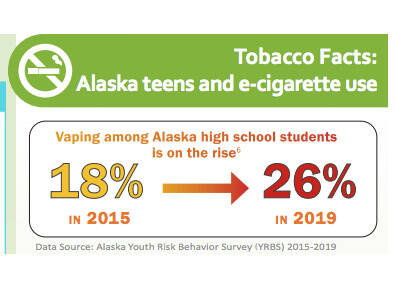Sitting before members of the Kenai Peninsula Borough School District school board on Monday, Tabitha Blades shook a viridian green bucket filled with electronic cigarettes.
“This bucket is all the vapes that I’ve taken away from the last quarter of the school year last year, and the first quarter of the school year this year,” Blades said.
She’s one of the assistant principals at Soldotna High School, where she said she is unofficially in charge of student discipline. That role, she said, puts her in direct contact with students who vape in school, which is not allowed, although she said she thinks students start vaping “much earlier” than high school.
The high school in January 2022 installed nine HALO Smart Sensors, which function like smoke detectors, but are calibrated to detect and analyze vapor in the air, Blades said.
During the first 40 days of the current school year, Blades said those devices alerted staff of nicotine detection 146 times, although not every alert resulted in an e-cigarette being found. The same devices on four occasions alerted detection of tetrahydrocannabinol, or THC — a mind-altering compound found in marijuana.
The majority of alerts, about 84%, occurred in boys’ restrooms, Blades said. Not every alert, Blades said, results in an e-cigarette being found.
Results from the 2019 Alaska Youth Risk Behavior Survey found that one in four students — 26.1% — said they currently used an electronic vaping product, such as e-cigarettes, vapes and vape pens, among others. That rate was slightly higher in the Kenai Peninsula Borough School District, where about 28.1% of students said they currently use an electronic vaping product.
Roughly half of KPBSD students — 49.4% — reported ever having used electronic vapor products, compared to 45.8% of students statewide. Between 2016 and 2021, Alaska saw the highest increase in rate of e-cigarette use among young adults, according to a report published earlier this year.
Blades said she is concerned about the addictive properties of e-cigarettes, telling board members that she regularly hears from students who say they struggle between hits.
“I wish I could make it through the day without hitting my vape, but I barely make it through a class without it,” Blades said one student told her, noting that Soldotna High School’s class periods are about 50 minutes long. “Sometimes I don’t make it.”
“It’s the first thing I do in the morning and the last thing I do at night,” Blades quoted another student as saying. “I can’t function without it.”
The U.S. Centers for Disease Control and Prevention says the addictive properties of nicotine, which most e-cigarettes contain, pose a risk to kids, teenagers and young adults. Adolescent nicotine use, the group says, harms the parts of the brain that controls attention, learning, mood and impulse control.
Other risks associated with e-cigarette use are associated with the aerosol those devices produce. The CDC says that, among the substances that can be included in the aerosol that e-cigarette users breathe in and then exhale are nicotine, ultrafine particles, heavy metals like nickel and lead and cancer-causing chemicals, among others.
Blade called the student confessions “disturbing,”
“The admissions of addiction — ‘I can’t stop,’ ‘I’d like to stop but I can’t,’ is disturbing to hear out of the mouth of a 15-year-old child,” Blade said.
In addition to installing vape detectors in school bathrooms, Blades said Soldotna High School has also revised its student handbook to more comprehensively address e-cigarette use and testified about the issue before the Alaska Legislature in response to vaping among students.
Blades said Soldotna High School also uses the programs INDEPTH, an educational alternative to suspension that teaches students about nicotine dependence and health habits, and Not On Tobacco, a voluntary program for youth who want to quit tobacco use.
Ultimately, though, Blades said ending youth e-cigarette use is a group effort.
“It’s going to take something a lot more than just us,” she said.
Multiple board members on Monday expressed interest in further examining the issue of e-cigarette use among KPBSD students. Blades’ full presentation can be found on KPBSD’s BoardDocs page.
Reach reporter Ashlyn O’Hara at ashlyn.ohara@peninsulaclarion.com.
CORRECTION: This story has been updated to correct Tabitha Blades’ job title. Blades is an assistant principal at Soldotna High School.

